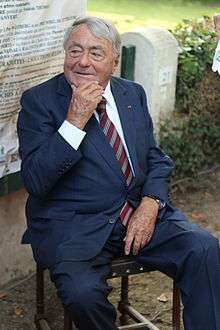Claude Lanzmann
| Claude Lanzmann | |
|---|---|
 Lanzmann in 2014 | |
| Born |
27 November 1925 Paris, France |
| Nationality | French |
| Occupation | Filmmaker |
| Years active | 1970-present |
| Spouse(s) |
Judith Magre (m. 1963; div. 1971) Angelika Schrobsdorff (m. 1971) Dominique Petithory (m. 1995) |
| Children | Sara Siegel, Angélique Lanzmann, Félix Lanzmann |
Claude Lanzmann (French: [lanzman]; born 27 November 1925) is a French filmmaker known for the Holocaust documentary film Shoah (1985).
Life and work
Lanzmann was born in Paris, to a Jewish family that immigrated to France from Eastern Europe.[1] He is the brother of writer Jacques Lanzmann. He attended the Lycée Blaise-Pascal in Clermont-Ferrand. His family went into hiding during World War II.[2] He joined the French resistance at the age of 17 and fought in the Auvergne.[3] Lanzmann opposed the French war in Algeria and signed the 1960 antiwar petition Manifesto of the 121.[4]
From 1952 to 1959 he lived with Simone de Beauvoir. In 1963 he married French actress Judith Magre. They divorced in 1971, and he next married Angelika Schrobsdorff, a German-Jewish writer.[5] He divorced a second time and married Dominique Petithory in 1995. He is the father of Angélique Lanzmann, born in 1950 and Félix Lanzmann, born in 1993.
Lanzmann's most renowned work, Shoah, is a nine-and-a-half-hour oral history of the Holocaust, broadly considered to be the foremost film on the subject. Shoah is made without the use of any historical footage, and uses only first-person testimony from Jewish, Polish, and German individuals, and contemporary footage of several Holocaust-related sites. Lanzmann persuaded Polish resistance fighter Jan Karski to be a witness in Shoah by calling forth—once again—his historical responsibility. When the film was released, the director also published the complete text, including in English translation, with introductions by Lanzmann and Simone de Beauvoir. It provides multiple keys to the philosophical and linguistic preoccupations of the producers. Through Shoah many viewers were first introduced to the work of Raul Hilberg, an American Holocaust historian.
Lanzmann has disagreed, sometimes angrily, with attempts to understand the why of Hitler, stating that the evil of Hitler cannot or should not be explained and that to do so is immoral and an obscenity.[6]
He is chief editor of the journal Les Temps Modernes, which was founded by Jean-Paul Sartre and Simone de Beauvoir. In 2009, Lanzmann published his memoirs under the title Le lièvre de Patagonie (The Patagonian Hare).
He is currently a lecturer at the European Graduate School in Saas-Fee, Switzerland.[7]
Legacy and honors
- On July 14, 2011, he received the French Legion of Honor.[8]
- At the 63rd Berlin International Film Festival in February 2013, Lanzmann was awarded with the Honorary Golden Bear.[9]
- 2010 Welt-Literaturpreis[10]
Bibliography
- Filmography
- Israel, Why (Pourquoi Israel) (1973)
- Shoah (1985)
- Tsahal (film) (1994)
- A Visitor from the Living (1999)
- Sobibor, Oct. 14, 1943, 4 p.m (2001)
- Lights and Shadows (2008)
- The Karski Report (2010)
- The Last of the Unjust (2013) about Benjamin Murmelstein, Elder of Theresienstadt
- Claude Lanzmann: Spectres of the Shoah (2015) 40-minute documentary about Lanzmann, directed by Adam Benzine
- Books
- Shoah: An Oral History of the Holocaust : The Complete Text of the Film. Pantheon Books, New York 1985, ISBN 978-0-394-55142-5
- The Patagonian Hare: A Memoir (translated by Frank Wynne). Atlantic Books, London 2012, ISBN 978-1-84887-360-5 ; Farrar, Straus and Giroux, New York 2012, ISBN 978-0-374-23004-3
- La Tombe du divin plongeur. Gallimard, Paris 2012 ISBN 978-2-070-45677-2
- Further reading
- Galster, Ingrid (2011), "'Eine große Qualität meines Buches ist seine Ehrlichkeit.' Postscriptum zu der Debatte um die Autobiographie Claude Lanzmanns", In Das Argument, 290, 72-83. (online) (unpublished English translation: "'One great quality of my book is its honesty.' Postscript to the debate on Claude Lanzmann’s autobiography" online)
- “From the Holocaust to the Holocaust”. Telos 41 (Fall 1979). New York: Telos Press.
References
- ↑ "Fuse Feature: A Conversation with Claude Lanzmann about his memoir, "The Patagonian Hare"". The Arts Fuse. Retrieved 2014-03-04.
- ↑ On Campus: "Claude Lanzmann", Columbia University News
- ↑ Lawrence D. Kritzman, Brian J. Reilly, Malcolm DeBevoise. The Columbia History of Twentieth-Century French Thought Entry "Claude Lanzmann"
- ↑ Israel's enemies take no prisoners., Tageszeitung, 6 July 2009
- ↑ "Nothing he hasn't done, nowhere he hasn't been". Lrb.co.uk. Retrieved 2014-03-04.
- ↑ Rosenbaum, Ron (1999). "Claude Lanzmann and the War Against the Question Why". Explaining Hitler: The Search for the Origins of His Evil. HarperCollins. ISBN 0-679-43151-9.
- ↑ Claude Lanzmann Faculty profile at European Graduate School
- ↑ 'La promotion du 14 juillet de la Légion d'honneur', in Le Figaro, 14/07/2011
- ↑ "Claude Lanzmann: an extraordinary prize for an extraordinary man". Vivamost.com. Retrieved 2013-12-16.
- ↑ "Auszeichnung: Claude Lanzmann erhält den "Welt"-Literaturpreis". Berliner Morgenpost (in German). October 2, 2010. Retrieved November 11, 2012.
External links
| Wikimedia Commons has media related to Claude Lanzmann. |
- Claude Lanzmann at the Internet Movie Database
- 'Claude Lanzmann on why Holocaust documentary Shoah still matters', Stuart Jeffries, The Guardian, 9 June 2011
- 'Witness to History: Claude Lanzmann’s Journey to Shoah, Weekly Standard, Oct. 8, 2012
- Claude Lanzmann Shoah Collection, Steven Spielberg Film and Video Archive, US Holocaust Memorial Museum, video excerpts of all interviews done for the film Shoah, with links to transcripts in original languages and English (includes unused interview with Benjamin Murmelstein from 1975, used in 2013 film)